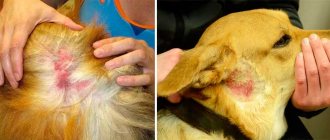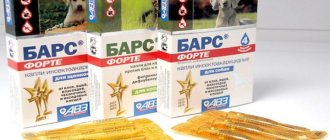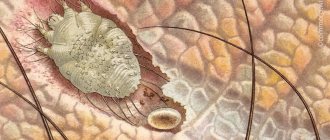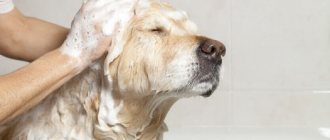What are the means of protection against ticks and fleas?
There are a lot of anti-parasite remedies on the market. They all contain substances that kill fleas and ticks. Let's look at the most popular ones.
Shampoos
The main function is the destruction of fleas and their larvae. Shampoos must be used strictly according to the instructions, no more than once every 2 weeks. Apply the product to the animal’s fur, wait for the time indicated on the package and rinse thoroughly.
The shampoo not only destroys parasites, but also relieves itching and cares for the dog's coat. It may contain:
- essential oils - for easier combing;
- plant extracts, such as calendula or chamomile, to combat irritations;
- methionine (to accelerate the growth of damaged hair).
Benefits of shampoos:
- universality - suitable for all dogs;
- effectiveness in the fight against parasites;
- convenient use, according to the instructions;
- safe even for puppies and pregnant dogs;
- the possibility of using it to treat pet’s things against fleas (just wash them with shampoo).
The main disadvantage is that the shampoo kills insects, but does not prevent their reappearance. You can’t use it too often, so if you go for regular walks in warm weather, shampoo may not be enough, but it can be used together with other products.
Drops
Drops are applied to the animal's withers. Almost all drops on our market last about 25 days. The parasite can bite a dog, but dies immediately after that.
Advantages:
- easy to use;
- versatility (destroy fleas, ticks, and often worms);
- action for several months.
The disadvantages include the fact that the product is not suitable for pregnant dogs and puppies under 3 months. Some drops are too aggressive, so you need to very accurately determine the dosage based on the weight of your pet.
Pills
The tablets act on parasites from the inside. The active substance is absorbed into the animal’s blood and then distributed throughout the body. The drug neutralizes the nerve endings of the parasite, after which it dies. The effect of the drug lasts about 1 month, with the exception of the drug "Bravecto" - it lasts 12 weeks.
Advantages:
- high efficiency;
- easy to use;
- safe for animals with allergies.
The downside is the need for individual selection with a specialist. An incorrectly chosen drug can lead to side effects: vomiting, diarrhea, itching. In addition, not every pet will agree to eat a tablet, even if it is carefully “disguised” as food.
Sprays
Sprays are natural and synthetic. The first ones are made on the basis of essential oils that repel insects. Can be used as a prophylaxis and additional protective agent, suitable for puppies, pregnant and lactating dogs.
Synthetic sprays contain an insecticide that paralyzes insects for several hours. After treatment, you need to comb the animal thoroughly. Validity period: 1–2 weeks.
Advantages:
- high efficiency;
- Possibility of use for processing objects and surfaces.
An incorrectly selected spray can be toxic to the animal, so in some cases it causes nausea and itching.
Collars
Flexible tape with a retainer contains the active substance. Upon contact with the animal, the collar heats up and the substance is distributed throughout the fur. Tapes can be natural or synthetic. The first ones contain essential oils and are suitable for pregnant animals and puppies. The second ones act more effectively and at the same time aggressively.
Advantages:
- convenient use;
- safety.
In some cases, individual intolerance to the ingredients may occur.
Kennel club "Vernost"
How to use tick repellents correctly
TICK AND FLEA TREATMENT
How dangerous are ectoparasites? In massive quantities they cause exhaustion and death of the animal. But even a single bite can cause great harm, as they are carriers of various diseases.
Ixodid ticks carry piroplasmosis (babesiosis) and tick-borne borreliosis (Lyme disease). Fleas are a source of infection with tapeworms (dipylidiasis). Mosquitoes can transmit leishmaniasis and dirofilariasis (heartworms).
Getting rid of fleas is not difficult - treatment with modern drugs protects against infection for up to six months. Mosquitoes are a big problem, but, fortunately, diseases transmitted by them are quite rare in the middle zone. The likelihood of infection is higher in the southern regions of Russia. Therefore, when going on vacation with your dog, check the epidemiological situation and treat the dog with appropriate medications in advance. Ticks are the main enemy and headache of all dog owners.
Ixodid ticks are ubiquitous and are infested with piroplasma on a massive scale. There are no remedies for them that provide a 100% guarantee of reliability! The problem is that highly toxic compounds that cause guaranteed death of the tick also harm the dog itself. In addition, some substances have the ability to gradually accumulate in the body. And you have to protect yourself from ticks for at least 6 months a year! When choosing a drug, you have to balance between reliability and toxicity. Therefore, be sure to look at what active substance is used. If the manufacturer does not indicate the composition, do not buy! Read the manufacturer's instructions carefully, and do not take advice from friends on walks!
What to choose - drops on the withers, spray or collar?
It all depends on the specific situation. With a high concentration of ticks, for greater reliability, you can combine drops and spray, or spray and collar. The main thing is that the active substance in them is from different groups in order to avoid an overdose. Sprays begin to act immediately after treatment. Drops on the withers should be absorbed into the skin and distributed over it, this usually takes at least a day.
FRONTLINE SPOT ON drops (Merial, France) – active ingredient fipronil
FRONTLINE spray (Merial, France) – active ingredient fipronil
PRAC-TIK drops (Novartis Animal Health, Germany) – active ingredient pyriprole
ADVANTIX drops (Bayer, Germany) – active ingredients imidacloprid and permethrin
BOLFO spray (Bayer, Germany) – active ingredient propoxur
HARTZ drops (HARTZ, USA) – active ingredient phenothrin
BLOKHNET drops (Astrapharm, Russia) – active ingredients fipronil, benzyl benzoate, dimethyl phthalate
BLOKHNET spray (Astrapharm, Russia) – active ingredients fipronil, benzyl benzoate, diethyltoluamide, juvemon
BARS drops (Agrovetzashchita, Russia) – active ingredient fipronil
BARS spray (Agrovetzaschita, Russia) – active ingredient fipronil
DANA drops (Api-San, Russia) – active ingredient diazinon
DANA spray (Api-San, Russia) – active ingredient permethrin
ROLF CLUB drops (NPF “Ekoprom”, Russia) – active ingredients fipronil, pyriproxyfen
ROLF CLUB spray (NPF “Ekoprom”, Russia) – active ingredients fipronil, pyriproxyfen
CLEANITY drops (NPF “Ekoprom”, Russia) – active ingredients fipronil, permethrin
CLEANITY spray (NPF “Ekoprom”, Russia) – active ingredient permethrin
VECTRA 3D drops (Ceva Sante Animale, France) – active ingredients dinotefuran, permethrin, pyriproxyfen
For puppies, pregnant and lactating bitches, FRONTLINE SPOT ON drops are usually used on the withers, as they are slightly toxic to mammals. I treat it once every four weeks if the dogs don’t bathe, or every three weeks if they do. I treat adult dogs that have no contraindications with BLOCHNET drops every four weeks. Additionally, I spray with DANA spray before each “dangerous” walk - in the forest, in the fields. And, of course, after every walk I carefully examine the dogs, since fipronil does not repel ticks - they crawl out of the fur, wander through it, but do not bite. Permethrin repels well, but treating a Labrador completely, “without holes,” and even once every two weeks, is hard work. In addition, permethrin is washed off with water. A morning walk in the dew, an afternoon swim in the lake... and I no longer know how protected my dogs are. Therefore, I only use it in combination with drops. The combination of two active ingredients - fipronil and permethrin, gives, from my point of view, the best result.
Collars contain long-lasting insoluble compounds that gradually transfer to the fur. They begin to act after a few days, when the substance is distributed. The collar must be worn constantly without taking it off.
KILTIX (Bayer, Germany) – active ingredients propaxur and flumethrin SCALIBOR (MSD Animal Health/Intervet LLC, Russia) – active ingredient deltamethrin BEAFAR (Beaphar, Holland) – active ingredient diazinon
BOLFO (Bayer, Germany) – active ingredient propaxur
I don't use collars for the following reasons. First, I don’t have one dog, but several. In games, they chew and lick each other, grab collars with their teeth - there is a high probability of poisoning. (In families where there are small children, it is also impossible to keep track of whether they touched the collar or washed their hands after that...) The second reason is that directly under the collar the concentration of the toxic substance is especially high, which causes skin problems. Of course, this is very individual and depends on the dog’s sensitivity, but it is not uncommon. The third reason is that collars smell strongly.
The first (spring) treatment against ticks should be carried out as soon as the “plus” night temperature has established.
The dog should not be washed three days before and two days after treatment.
Mark each treatment on your calendar so you don't miss the next one.
If you combine products (drops + spray), treat with the second product no earlier than 10 days after the first.
After each walk, inspect your dog and destroy any ticks found.
If the dog is dark and ticks are difficult to see, comb the fur with a fine comb.
If, despite the measures taken, the dog is bitten by a tick, carefully monitor its well-being for three weeks. At the first signs of lethargy, refusal to eat, you need to measure your rectal temperature, and if it is elevated (the norm is 38.4 - 39.0), go to the vet immediately. clinic and do a test for the presence of Babesia in the blood. With timely treatment, piroplasmosis is curable, but every hour of delay reduces the chances of a successful outcome!
Spring-summer-autumn, time for mandatory treatment of dogs against ticks!
Why are treatments not always effective?
When there are cases of piroplasmosis in my kennel, I always ask the owners in detail how and with what the dogs were treated. An interesting pattern emerges - almost always either the deadlines or the rules for using drugs were violated. Therefore, I would like to remind you once again how to properly treat your dog against ticks with drops.
1) 3 days before treatment, the dog should not be washed, not bathed, but rather washed with detergents. Why? Because the fatty layer, in which the protective agent should actually be distributed, is washed off
2) You cannot bathe for 2 days after treatment. Why? Because the protective agent must be distributed throughout the fatty layer covering the dog’s fur, and this takes time.
3) Drops should be applied to the skin (not to the fur), pointwise! Do not pour the entire pipette in one place, but distribute it drop by drop along the back, starting from the back of the dog’s head to the middle of the lower back.
4) Drops must be stored correctly - in a dark place, at a temperature from 0 to 35 degrees. Therefore, it is very important to buy drugs in trusted places where storage conditions are met and where there is no chance of purchasing a counterfeit.
5) Write down processing times! You cannot rely on memory; even one missed day can be fatal. Frontline Spot drops last for 3 weeks if the dog bathes regularly or 4 weeks if the dog does not bathe. Follow these deadlines!
6) After each walk, inspect the dog and remove crawling ticks from it. Drops of ticks do not repel ticks, they seem to “make the dog not tasty.” Therefore, there is time to collect them and destroy them.
How to protect your dog from ticks
Almost all owners have heard that ticks are dangerous for dogs. Not everyone knows what the dangers are, what they cause and how to properly protect your dog from ticks. Here are some misconceptions of owners that we encounter in the process of work:
-that ticks cause encephalitis in dogs, -that it is enough to put drops on the withers once at the beginning of spring and the dog will be protected for the entire period, -that a tick can only be “caught” in the forest, and since we don’t go into the forest, then There is no need to treat the dog - if you find a tick on the dog, you need to urgently administer serum like in humans or start treatment.
In this article we will try to sort everything out.
Tick season begins with spring warming and snow melting. For humans, ticks are carriers of the causative agent of viral encephalitis (a disease of the central nervous system), borreliosis, and in dogs quite often a blood parasitic disease occurs - piroplasmosis (blood cells - red blood cells are affected) or, somewhat less frequently, borreliosis (otherwise known as Lyme disease). The peak activity of ticks occurs in spring and autumn, so it is necessary to carry out treatments from early spring to late autumn. Simply applying drops to the withers at the beginning of spring is not enough; it is necessary to carry out treatments regularly, the interval depends on the type of drops. We will write about the pros and cons of anti-tick medications below, but now we will tell you about the measures that need to be taken if your dog has already been bitten by a tick:
1. After each walk, the dog must be examined and felt with your fingers, especially with thick hair, and especially carefully the head, neck, chest and groin in order to detect and remove the tick as early as possible. Ticks attack dogs not only in the forest or park, as some dog breeders mistakenly believe, but also in courtyards and squares.
2. If a tick is found, it must be removed. It is better to do this at the veterinary clinic. The place where the female tick’s head meets the abdomen is very tender and easily tears, so you can’t pull the tick by the abdomen, you can simply tear it off, the head and legs will remain in the skin, it is very difficult to remove them and, as a rule, a local inflammatory process begins. You need to remove the tick with a special device (can be bought at a veterinary pharmacy) or tweezers using a twisting motion. To protect yourself, wear gloves because... It is not known what kind of “filling” this tick has – whether it is dangerous for a dog or a person. After removal, the wound must be treated with an antiseptic, for example, iodine. Ticks do not sink in water and are practically impossible to dry out. You should not try to crush them - this may lead to the spread of the infection they carry. The best way to kill a tick is to burn it.
3. The moment of infection with piroplasmosis does not occur immediately at the moment of the bite, as they write in some articles on the Internet, but only on the second day, when the female drinks blood and squeezes back the liquid (unnecessary) part of the blood, then the piroplasm from the salivary glands of the tick under pressure (like a syringe) and enter the dog’s blood. Therefore, it is unlikely that a newly attached tick with an unfilled abdomen will cause disease.
4. Next, you need to very carefully monitor the dog’s condition and measure body temperature rectally every day. The fact is that not all ticks are carriers of piroplasmosis; a “healthy” tick can also attack a dog. And, as a rule, before clinical signs of the disease appear, piroplasms are not detected in the blood. The first signs for which you should immediately consult a doctor are: an increase in body temperature above 39.5 degrees, lethargy, refusal to eat, the mucous membranes of the eyes and mouth are pale or yellowish, urine with blood or a dark color, weakness of the hind limbs, may have diarrhea. The destruction of red blood cells occurs in the body, which affects all organs, primarily the heart, liver, kidneys, spleen, and pancreas. Owners make a big mistake when, seeing such manifestations, they do not go to the clinic, but carry out symptomatic treatment at home in the form of antipyretics, treats to increase appetite, etc.
If you removed the tick yourself, then if at least one of the listed signs appears (for example, only lethargy), take your pet to the clinic. Recently, piroplasmosis often manifests itself atypically, or blurred in a chronic form. It happens that you have to take blood tests several times to find parasites. The period from infection to the onset of clinical signs can be from 2 to 20 days.
5. A very important point is urgent, or timely contact with a doctor for diagnosis and treatment. The earlier the disease is detected and treatment is started, the greater the likelihood of the pet’s recovery, in a short time (for example, 3 days) and for less money. There are often cases when owners do not understand the danger of the disease, wait several days and come to the appointment when it is already difficult for doctors to save the dog.
6. An accurate diagnosis can only be made using a blood smear from peripheral small vessels. As a rule, a drop of blood is taken on glass from the ear, rarely from the claw. In our clinic, the analysis is ready immediately at the appointment in 15-20 minutes. In the photo - there are 2 pear-shaped purple formations in the erythrocyte - these are piroplasms.
7. Treatment consists of the administration of an antiparasitic drug and a course of drips that relieve intoxication and help the body recover. There is no serum with antibodies, as in the case of human tick-borne encephalitis. The antiparasitic drug is very toxic, so it is administered only after a diagnosis has been established, and is calculated strictly based on the dog’s weight. A course of treatment, depending on the weight of the dog, costs from 3 to 7 thousand rubles.
8. Chronic course. In a chronic course, all of the listed symptoms are blurred. And it is not always possible to immediately determine the cause of the disease. After contracting piroplasmosis, 80% of dogs are carriers of piroplasma (depot in the spleen); there are no clinical signs. Stable immunity against piroplasms is not developed, so the animal can get sick again and again. There are cases where, for example, a dog suffered from piroplasmosis for two years in a row and received treatment; in the third year the disease was again confirmed in the laboratory, but the owners refused treatment; the dog, fortunately, recovered. But this is the exception rather than the rule.
9. Prevention.
For prevention, the veterinary drug market offers: drops on the withers, sprays, collars, and since 2009, the Pirodog vaccine (Merial company, France) has appeared in our country. The effects of external preparations differ in: repellent (repellent sprays), contact (ticks die upon contact with treated hair and skin) and protection against infection with piroplasmosis, but do not protect against tick attacks.
1) Drops on the withers
(spot-on). Drops on the withers against ticks and fleas are now on sale in a large selection. There are imported and domestic ones, they have different active ingredients, different periods of protection against ticks and fleas, the price ranges from 25 to 700 rubles. The most important condition is to carry out the treatments correctly and in a timely manner, i.e. if the packaging says that the drops protect against ticks for 4 weeks, then you need to observe an interval of 4 weeks, and not 4.5 or 5 or more, because even a few days that the dog remains unprotected can lead to piroplasmosis. Another important point is to buy pipettes strictly according to the dog’s weight, apply directly to the skin, and do not bathe the dog 3 days before and after treatment. Always carefully read the instructions for anti-tick medications - what weight the pipette is designed for, how long protection is guaranteed, at what age and weight of a puppy or dog the drug can be used, and whether it is suitable for pregnant and lactating bitches (!).
The drops are convenient and easy to use, and can be easily selected for a dog’s specific weight.
– Frontline spot-on (France) – the manufacturer guarantees protection against ticks of 95% and against fleas of 100%, subject to all treatment conditions, does not have a repellent effect, so there is no need to be afraid that ticks can attack the dog, it protects against infection with piroplasmosis . When a female tick drinks blood containing the active substance fipronil, she dies without having time to squeeze back the liquid part of the blood and release piroplasm into the dog’s blood. Fipronil is absolutely safe for dogs, does not cause allergies, and is non-toxic. Frontline can be used on pregnant and lactating bitches, as well as puppies from 2 months of age and starting with a puppy/dog weight of 2 kg (up to 2 months, even from birth, and up to 2 kg Frontline spray is suitable). The manufacturing company Merial was the first in the world to use purified fipronil, has conducted and continues to conduct a lot of research on its products and values its reputation.
– Rolf-club, Praktik (Germany), Mr. Bruno, Fiprex – generic drugs created on the basis of fipronil after the discovery of Frontline, manufacturers did not need to conduct research and confirmation, because they followed the beaten path and the effectiveness of such drugs was declared to be 80% .
– Hartz (USA), Advantix, Dana (Russia), Celandine (Russia) – preparations based on permethrins or organophosphorus compounds – have a contact effect, i.e. The tick dies upon contact with the animal's fur. Disadvantage - they are easily washed off with water (dew, rain, puddles, ponds), not suitable for pregnant and lactating dogs, sick and weakened dogs, as well as puppies under 6-8 weeks of age. It is better to use such drops more often than what is written on the package. – Stronghold, Advocate, Advantage drops DO NOT PROTECT against ticks
2) Sprays.
Sprays are also based on different substances: fipronil (Frontline) and pyrethroids (Dana, Celandine, Bolfo-spray).
– Frontline spray is convenient to use for puppies under 2 months of age and weighing less than 2 kg, for smooth-haired small dogs, for hairless dogs, and also as additional protection to Frontline spot-on drops for treating open areas of the body (ears, jowls) , belly, between the toes) for dogs that like to bathe frequently or, for example, hunting dogs. In this case, there will be no overdose of fipronil, guaranteed by the manufacturer. The meaning of protection is the same as that of Frontline spot-on drops. It is not recommended for use in large (too high consumption), thick-haired dogs (difficult to reach the skin), because the animal should be wet from the drug when properly treated.
– Sprays based on pyrethroids – must be applied 1-2 times a week (see instructions), sprayed against the growth of fur, avoiding contact with eyes, mouth, nose, this must be done outdoors (since inhaled vapors are toxic!), cannot be used puppies under 6 weeks of age, pregnant, lactating, sick, weakened animals, avoid licking the drug after treatment by the animal itself or other animals.
When owners have complaints that “the drug is not working,” this can mean two things:
a) the owner and his animal are included in the remaining 100 percent guaranteed by the drug manufacturers (for example, the manufacturer’s guarantee is 80%, then you are included in the remaining 20), subject to compliance with all rules and processing times.
b) the owner carries out the treatments incorrectly - the first treatment is carried out not at the beginning of spring, but later, the interval between treatments is not observed, one pipette is dripped onto several animals in order to save money, the dog is bathed, it swims in natural springs or gets exposed to rain for 3 days before or after treatment with drops or sprays, or taken out for a walk immediately after applying the drops. For example, abroad all vaccinations, treatments against worms, as well as treatments against fleas and ticks are carried out only by a veterinarian, and “incorrect” or untimely treatments are simply excluded.
3) Collars. The collars are impregnated with drugs that create a protective cloud around the dog (repellent effect), and also spread through the coat and sebaceous glands, providing contact protection. The service life of the collar is 5-7 months, it must be worn without taking it off so that there is constant contact with the fur and skin, and not as an accessory for a walk. Although many collars say that they are waterproof, if your dog bathes frequently, it is better to change the collar before the specified time. It should not be used by pregnant, lactating, sick or weakened animals, puppies under 2 months of age, and some, for example, Beafar, can only be used from 6 months of age. May cause local irritation upon contact with skin in the neck area.
Some owners play it safe and use both drops and a collar for protection. It is better not to do this, because when mixing two drugs from different groups, something third is obtained on the skin, it is unknown how it affects the animal’s body, and it is quite capable of causing an allergic reaction or intoxication.
4) The Pirodog vaccine (Merial, France) was developed to create immunity in dogs against piroplasmosis, the vaccine effectiveness is 76-80%. Vaccination must begin at 5 months of age, when the puppy has already been vaccinated against viral infections. The vaccination is given twice with an interval of 3-4 weeks, revaccination after a year, if the dog is often attacked by ticks - then once every six months. If the dog is a carrier of piroplasma (previously had the disease), then the vaccine can provoke the disease, i.e. manifestation of clinical signs (in this case, standard treatment + treatment with drops is necessary). Pregnant dogs cannot be vaccinated; vaccination cannot be combined with other vaccines (with the exception of vaccines against leptospirosis and rabies).
Many experienced dog breeders have already made their choice in favor of one or another method of protecting their pet from ticks and piroplasmosis. We hope that this article will help novice dog owners make their choice, and will also clarify the existing ideas and beliefs of dog breeders about anti-tick treatments.
Inchina Anna Aleksandrovna, veterinarian at the MEGAvet clinic
How to protect your dog or cat from tick bites? What to do if a tick bites your pet?
Tick-borne encephalitis and tick-borne borreliosis are not dangerous for dogs and cats; they do not suffer from these diseases. For them, ticks are primarily dangerous due to the infectious disease piroplasmosis.
Piroplasmosis is a serious infectious disease of dogs and cats, which, unfortunately, is quite widespread. The causative agent of piroplasmosis is single-celled microorganisms of the species Piroplasma canis, which parasitize blood cells - erythrocytes. The main way of transmitting this disease between animals is through a tick bite. Most piroplasmosis diseases occur during the active season of ticks, that is, in spring and autumn.
First of all, remember to protect your pet from tick attacks.
Today there is a large selection of different products in the form of sprays, collars and drops on the withers. How do these drugs work, and which one should you choose to protect your pet? And the form of release of the drug, and the quality of the product, and the authority of the company that produces it, matter.
The composition of any form of a protective drug includes an active substance and a filler in which this active substance is dissolved. Drops differ from sprays in the concentration of the active substance per unit volume, and with insectoacaricidal collars both the active substance and the solvent are applied to a special synthetic base in the form of a tape (collar).
Upon contact with the skin after applying drops, sprays or while wearing a collar, due to the lipophilic properties of the filler (the ability to easily dissolve in fats), the insectoacaricide is absorbed into the subcutaneous tissue and accumulates in the sebaceous follicles. From there, along with the secretion, the insectoacaricide is released onto the surface of the skin in small portions for a long time. Therefore, treated animals can be bathed within two to three days.
It should be borne in mind that ticks and other insects can attach to the animal’s fur, but immediately after this the active substances of the protective agent begin to act on them. This leads to a sharp decrease in tick activity, and then to death. The manufacturer's recommended application regimens for most products are as follows: the drug must be applied to the animal's skin in some way - drops and sprays are distributed at several points once every two to four weeks, and the active substance from the collars is gradually absorbed into the skin while it is worn.
However, with this method of application, the highest concentration of the protective substance is created in the immediate vicinity of the animal’s skin, and very unevenly. This is quite enough to protect against fleas, lice and lice. But for more “tenacious” ixodid ticks, additional protection is required in the form of daily application of a spray to the animal’s fur. This is especially true for long-haired dogs and cats.
Based on this, the most effective means of protection are insectoacaricidal sprays, used according to the following scheme: basic treatment by applying a spray to the skin once every few weeks, in the amount recommended by the manufacturer, plus daily spraying of a small amount on the animal’s fur.
For example, “Frontline” spray, 250 ml French or its analogue “Fipron” spray, 250 ml Czech is recommended to be used as follows: once every three to four weeks, at the rate of four presses of the distribution head per kilogram of live weight of the animal, sprayed onto the skin animal - as a basic treatment (the spray distribution head has two positions - for jet application and spraying), plus daily spraying on the fur (two to six presses of the distribution head are enough).
A combination of drops on the withers (as a basic treatment) and sprays (for daily treatment) containing the same active ingredient is acceptable. You can use this method, for example, the drug "Frontline", which is available in the form of drops on the withers and in the form of a spray. The combination of insectoacaricidal collars, drops on the withers and sprays from various companies cannot be considered rational for the following reasons. Firstly, when two or more protective substances interact on the surface of an animal’s skin, a third, less effective or even toxic substance can be obtained, and secondly, the likelihood that your pet will develop an allergic reaction sharply increases. It is important not only how effectively the drug acts on parasites, but also whether it has side effects (high toxicity, allergenicity). Therefore, it is better to choose high-quality, proven drugs.
There are no other preventive means of preventing infection with piroplasmosis: to date, neither a vaccine nor serum (immunoglobulin) against this disease has been invented. It’s worth mentioning right away that the listed insectoacarizid agents, even with daily use, do not protect one hundred percent from tick attacks, so an additional examination of the animal after a walk will not hurt.
What to do if, despite all the measures taken, the dog is still bitten by a tick?
First, remove and burn the parasite.
You should not remove a tick with your bare hands (use tweezers, gloves, etc. - the main thing is to avoid contact with the tick on your skin and mucous membranes - there is a danger of contracting other diseases that are already dangerous to humans.
It is convenient to remove ticks with curved tweezers or a surgical clamp; in principle, any other tweezers will do. In this case, the tick must be grabbed as close to the proboscis as possible, then it is carefully pulled up, while rotating around its axis in a convenient direction. Usually, after 1-3 turns, the entire tick is removed along with the proboscis. If you try to pull the tick out, there is a high probability of it breaking.
There are special devices for removing ticks.
These devices have an advantage over clamps or tweezers, since the body of the tick is not compressed, squeezing the contents of the tick into the wound is avoided - reduces the risk of contracting tick-borne infections.
The Uniclean Tick Twister has proven itself well - this device for removing ticks can be purchased in Russia.
If you are unable to remove the tick yourself, contact a veterinarian.
Secondly, pay attention to the general condition and behavior of your pet: lethargy, refusal to feed, increased body temperature to 39.5-410 C, change in the color of urine - any of these symptoms is a reason to contact the clinic.
But if you receive an offer to give your dog a “tick injection” (this is the usual wording of both dog owners and “persons of para-veterinary passion”), then think carefully before accepting this help. Human viral encephalitis immunoglobulin is in no way suitable for the prevention or treatment of piroplasmosis. In addition, the use of this drug, which is very non-specific for animals, not only will not bring any benefit, but can also seriously allerge the dog’s body (and cause significant damage to your wallet through pointless spending).
There is also no need to rush into administering a specific antipyroplasmid drug, such as veriben or azidine. On the one hand, these drugs are extremely toxic (in fact, they are poisons), on the other hand, their effect does not last long. Therefore, if the tick that has bitten an animal turns out to be uninfected (and on average 3 to 14 percent of insects are infected with piroplasmas), then with the so-called preventive therapy you will deal a heavy blow to the entire body, to the liver and immune system in the first place.
If the worst happens, and a couple of days after the tick bite you notice something wrong in the dog’s behavior, immediately go to the clinic. Piroplasmosis is a rapidly developing disease: only a few days can pass from the appearance of the first clinical signs (often unspecific) to severe toxic damage to the body (or even death).
At the veterinary clinic, in addition to conducting a clinical examination, your pet must be tested for piroplasmosis. A drop of blood for a smear is taken from the dog’s ear (not from a vein!) - it is in the peripheral vessels that the largest amount of piroplasms is deposited. The diagnosis of piroplasmosis is considered established only after its laboratory confirmation. If laboratory diagnostics are not carried out, then even if the classic triad of symptoms characteristic of piroplasmosis appears: hyperthermia (high temperature), hematuria (“bloody urine”) and ectericity (jaundice) - no doctor is immune from fatal errors.
Therapy for piroplasmosis should not be limited to only a course of a specific anti-pyroplasmosis drug. Such limited treatment is fraught with the development of a host of chronic diseases in the future. Moreover, a dog can become infected more than once: immunity is not formed after an illness.
As already noted, with piroplasmosis, the kidneys, liver and hematopoietic system are primarily affected, on which the state of immunity largely depends. And if kidney-hepatic problems are usually not forgotten, then not all veterinary specialists remember about the total immunodeficiency that accompanies piroplasmosis, which arises as a result of the combined toxic effect of piroplasms and poisons introduced to destroy these same piroplasms.
Moreover, in this case, not every immunostimulant is suitable for correction. First of all, it should be a drug that stimulates hematopoiesis (i.e., the production of new red and white blood cells in the blood depots) in the most effective way and, at the same time, activates existing cells of the immune system.
The most modern product that meets these requirements is RONKOLEUKIN® (IL-2), produced (St. Petersburg). The use of this immunomodulatory drug in the complex therapy of piroplasmosis will not only facilitate the fight against the disease itself, but will also help to avoid unwanted complications after treatment.
Tools and accessories for tick removal
It is convenient to remove ticks with curved tweezers or a surgical clamp; in principle, any other tweezers will do. In this case, the tick needs to be grabbed as close to the proboscis as possible, then it is gently pulled and at the same time rotated around its axis in a convenient direction. Usually, after 1-3 turns, the entire tick is removed along with the proboscis. If you try to pull the tick out, there is a high probability of it breaking.
Currently, industry, including Russian industry, has launched the production of special devices for removing ticks from both people and animals. Most often this is a hook similar to a curved two-pronged fork. The plier is inserted between the teeth and then unscrewed.
These devices have an advantage over clamps or tweezers, since the body of the tick is not compressed and the risk of contracting tick-borne infections is somewhat reduced.
Tick Twister (TICK TWISTER) - a hook for removing ticks. Externally, the device looks like a small nail puller. The kit includes two hooks for removing large and small ticks. The tick is grabbed from the side, slightly pulled and twisted.
How to properly treat your dog for ticks?
- Drops from parasites must be distributed evenly: on the dog’s withers, on the top of the head, behind the ears. These are places where the pet cannot lick the drug.
- A flea collar is not recommended for use if you have small children or other pets at home. Since they can touch it with their hands or tongue.
- The drops and collar take effect within a few days, but the spray works almost immediately.
- When treating an animal with a spray, pay special attention to the stomach, sides, and groin area. When applying the product to the face, first spray onto the glove and then rub it into the pet's fur, avoiding contact with the eyes and mouth.
- Do not treat dogs with cat products. They can be toxic to pets.
- If the animal weighs less than 2 kg, use products in which the dose can be easily adjusted, such as a spray or drops.
Symptoms of fleas in a dog
Fleas on an animal's body can be seen with the naked eye, especially if the pet's fur is short and light. Otherwise, parasites are best visible on the stomach. You can also notice brown bugs while swimming. They are afraid of water and thrash about more, falling off their bodies.
If the dog is examined regularly, then even insect larvae are not difficult to detect. You need to run your hand against the hair growth, white round eggs will let you know about the appearance of an unpleasant guest. In addition, brown grains may be visible on individual hairs and partings - a product of the flea's vital activity.
The most striking symptoms of infection:
- Severe itching all over the body or in individual parts, the animal itches intensely, tears the skin, gnaws on unpleasant parasites;
- The appearance of irritations on the skin, burgundy spots;
- Scratches and bald patches are visible;
- Dandruff may appear, hair may fall out;
- Irritability, nervousness;
- Loss of appetite, weight.
Symptoms may change if fleas cause additional illnesses or allergic reactions. With prolonged absence of treatment, secondary additional symptoms appear: indigestion, hyperthermia, changes in the color of the eyeballs.
Fleas can carry the following diseases: typhus, salmonellosis, hepatitis, and other infectious diseases.
How does infection occur?
Scientifically, there are about 2,000 species of fleas . The main ones can be divided into 5 groups: feline, canine, chicken, rat and human. Dogs can pick up any parasite. The insects are small, flattened on the sides, with three pairs of legs. They are not burdened with wings and other devices, but are quite maneuverable and fast. Most often, fleas are brown or yellowish.
- Parasites are dangerous because they reproduce at an incredible speed . Every 3-4 days the female lays many eggs. Most often, she does this on environmental objects: among leaves, on carpets, in plush toys. The larvae are born after 2-14 days and become sexually mature within a week.
- Thanks to the flea's ability to jump long distances, it is not difficult for it to infect any creature. A dog can pick up insects from other animals, in a pile of leaves, or just in the grass. There are often cases when the owner himself brings parasites into the house on his clothes without even noticing it. In addition, females not only lay their eggs, they throw them a considerable distance, which can also cause infection.
Why fleas are dangerous for dogs and humans
The main danger lies in unpleasant symptoms and further consequences if left untreated for a long time. A dog can actually seriously damage the epidermis in an attempt to relieve itself from itching. Puppies even suffer from anemia (anemia) with numerous bites. Dermatitis and fungi often develop after bites, and allergic reactions can occur.
The flea is the most numerous carrier of infectious diseases: plague, brucellosis, salmonellosis, anthrax, encephalitis. In addition, insects carry worm larvae.
As for the danger to humans, expert opinions are divided . Some of them believe that dog parasites do not attack humans. In fact, fleas cannot live on the human body, but they bite just like animals. The bites turn red, itch, and allergies may appear. Also, the risk of contracting infectious diseases is no less than in dogs. There have been cases of cucumber tapeworm infection due to accidental ingestion of an insect.
How to treat a dog with drops
Do not bathe the animal 2 days before use.
- Carefully unpack the dropper with drops.
- Part the fur and drip the product onto the animal's skin.
- Apply it in a place where the dog cannot lick it off - on the withers.
- Squeeze out the required dose of the drug as directed on the package.
- Rub the product into the dog's skin with light massage movements.
- Play with your pet or distract him for a while until the product is absorbed, so that the dog does not rub it on the sofa, carpet, or his bed.
After application, refrain from swimming for a couple of days. Do not comb the dog or touch the fur with your hands.
How does infection occur?
Many dog owners are sure that their pet Tuzik, Rex or Polkan will definitely not catch fleas, since he does not leave the house and does not come into contact with stray relatives. However, even those pets who simply visit the toilet at home can become infected.
This happens for the following reasons:
- As a result of contact with sick animals . If a stray dog continuously itches, bites itself and literally bites into its fur, this indicates the presence of parasites. If a pet has come into contact with a suspected flea carrier, the pet should be thoroughly examined.
- After walking on the grass . Often, parasites literally fall from an infected animal, remaining in the grass. Climbing onto the highest blades of grass, they patiently wait for their next victim. And given the fact that fleas can jump 30 cm in height and 20 cm in length, it is not surprising that absolutely any animal passing by can become their victim.
- Through larvae . Baby fleas are no less dangerous than adult fleas. They can fall from an infected animal onto the grass, ground, or road. Eggs often end up in the house: a person brings them on the soles of his shoes or on his trousers.
The last point creates a risk of infection for pets that do not go outside. Thus, the danger of flea infection exists for all dogs, regardless of how often they are outside the home.
Even if the animal has been cured, the infection may recur, since insects and their larvae often remain on the dog’s personal belongings or attack furniture, carpet and other household items.
How to choose a tick and flea collar for dogs
To choose an effective and comfortable anti-parasite collar, you need to understand the classification and sizes. The following types exist:
- Biological. Natural, optimal for puppies, pregnant dogs and animals recovering from illnesses and surgeries. Made from herbal preparations.
- Ultrasonic. Without foreign odors, safe for animals. They work on the principle of sending ultrasonic waves.
- Chemical. They contain many toxic substances that kill fleas and ticks. Suitable for healthy adult animals.
Collars are classified according to their length as follows:
- Up to 38 cm – for small dogs (toy terriers, chihuahuas, spitz).
- From 58 cm – for medium breeds.
- From 70 cm – for large dogs.
Also pay attention to the composition of the collar, manufacturer and cost.
Folk remedies
You can fight fleas using certain folk remedies. The main advantages of this method: safety, accessibility and low price.
Herbal infusions
Fleas cannot tolerate the aroma and taste of wormwood.
For a long time, fleas on dogs were eliminated with the help of wormwood. Parasites cannot tolerate the aroma and taste of this herb. The animal is bathed in a wormwood solution (2 tablespoons of dry herb infused in 1 liter of boiling water).
Tansy and eucalyptus have a similar effect. This way you can effectively remove parasites from the fur of even very small dogs.
Garlic
2 cloves of garlic are crushed or finely chopped, add 250 ml of water and leave for 8 hours. The resulting solution is used to treat areas of the pet’s body that he cannot reach on his own (head, neck).
Onion
Has an effect similar to garlic. A piece of laundry soap is mixed with water (250 ml). Chop the onion and add it to the solution. The resulting mixture is treated with the dog’s fur and washed off after 10 minutes. If there are a lot of parasites, the application of the onion solution can be repeated after some time.
Essential oil
Lavender, eucalyptus, and citrus oils are suitable for fighting fleas. Pour a few drops of oil into 1 liter of water and apply the solution to the dog’s fur.
Vinegar
Vinegar is diluted with water in a ratio of 1:3 and applied to the dog’s coat. After an hour, the fur is combed out to remove dead fleas, their eggs and pupae.
What tablets are given to dogs to prevent tick bites?
The tablets have a preventive effect against parasites, and also destroy existing fleas and ticks. In addition, the product kills internal parasites in the animal’s body.
For preventive purposes in the spring and summer, tablets are given to pets monthly, starting a month before the start of the tick season and ending a month after it ends.
The tablets are available in chewable form and have an attractive aroma and taste for the animal. They can be given to the dog along with food. The main thing is to make sure that the pet chews the tablet completely.
The following remedies are considered the most effective:
- "Bravecto";
- "Frontline NexgarD";
- "NexgarD Spectra";
- "Simparinka";
- "Comfortis".
Signs of infection
Often, owners begin to breed fleas on their pets when there are already a lot of fleas and they pose a potential danger to the dog. To prevent negative consequences for your pet’s health, the animal must be carefully examined and its behavior observed.
The following changes in your pet's behavior may indicate the presence of fleas:
- the animal sleeps restlessly and constantly tries to change its resting place;
- the dog jumps up suddenly, having previously been in a calm state;
- the pet itches quickly and intensely, which is significantly different from habitual scratching.
If the owner detects one or more symptoms, the dog’s skin should be examined. Dried blood and inflamed areas indicate the presence of parasites.
But it is not always possible to track parasites on the dark fur of pets. You can determine whether your pet has fleas by performing a simple test.
This will let you know if your dog has flea excrement. The owner should arm himself with a fine-toothed comb and carefully comb the pet’s fur with it. If your dog is infested with fleas, the comb will be left with traces of insect feces in the form of characteristic black dots.
If your dog is prone to allergies or has very sensitive skin, a red rash will form on it. Typically, the inflamed areas are localized on the withers, behind the ears, on the stomach and inner thighs. Purulent ulcers gradually appear at the bite sites. The pet's fur begins to shed profusely.
In severe cases of infection, the dog has bald spots on the withers and croup at the base of the tail. Lack of veterinary intervention can lead to complete hair loss and even death of the animal.
Which product works best against ticks and fleas?
The best protection for your pet is to use several products at the same time, since one drug is not enough.
First you need to destroy existing fleas. Shampoos and sprays are suitable for these purposes. Then you can use a collar, tablets and drops on the withers. It is necessary to select a combination of drugs only after consultation with a veterinarian.
Tablets destroy parasites from the inside, drops – from the outside. The collar is needed for prevention; it repels insects. Such reliable protection will definitely prevent fleas and ticks from biting the animal and harming it.
In order for the protection to be effective, along with the animal itself, its bed, carrier, and clothes are also treated.
Conclusions and recommendations
Anti-tick drops for dogs are very different, and the choice must be approached with the utmost seriousness and responsibility. Because today their competent use is a necessary and mandatory protection tool.
Knowing the types of ixodid (encephalitis) ticks, their habitats, as well as their development characteristics, you can arm yourself with effective means of protection against bites.
The main argument in choosing is the active ingredient of the drug and its dosage, as well as the development and health characteristics of your pet.
It is better to choose 2- and 3-component preparations. If in any doubt, consult your veterinarian.
In addition to drugs applied by drop, other means of protection against ticks and fleas are also widely used - sprays and aerosols, tablets , collars and ultrasonic key fobs. About them in separate materials on the site.
Strengthen your dog's body
So, we see that it is quite possible to reliably protect your dog from fleas, ticks and the diseases they carry. But in the spring, you should also pay attention to the general health of the animal, because weakening of the body and decreased resistance - not uncommon phenomena after a long winter - hospitably open the gates to any infections.
Pay attention to your dog’s diet; it should not only be complete, but also support the animal’s immunity. It is very good if you supplement your pet’s diet with probiotics, which perfectly protect the body from external aggressive influences and increase its resistance to infections.
Now there are ready-made industrial feeds on sale that contain live probiotics. If you take care not only of the timely use of insecticides, but also of your dog’s daily healthy diet, spring and summer will bring only joy to both of you.
A little about ticks
Ticks love to live in places where there are a lot of animals - their intermediate hosts, they love fields with hares and hamsters (such places can be identified by burrows, dogs sniff and mouse in these places; if you see signs of such a hunt, it is better to leave this place), they do not disdain proteins.
The tick, like a spider, waits for its victim sitting on blades of grass; when a dog passes by, it clings to the fur, after which it crawls to its favorite places to bite. A tick bites like a spider or mosquito, i.e. in the process, it releases the contents of its salivary glands into the blood of the victim - this is how dangerous diseases enter the body of dogs and humans.
Why are fleas dangerous?
With the appearance of these “uninvited guests” the dog becomes very restless. In addition to behavioral features, the following may appear:
- Allergy to flea saliva. Moist patches appear on the skin.
- Itching. It can be of different intensity. Because of it, the dog tries to comb out (gnaw out) problem areas. Weeping wounds and bald patches appear on the skin.
- Manifestation of secondary infection. Many microorganisms live on a dog’s skin, and this is normal. But with the advent of a more suitable environment for reproduction (open wounds, wet areas), their number becomes catastrophic, and this threatens not only the health, but also the life of your pet.
Fleas can cause a sensation of intense itching, causing the animal to scratch the skin until blood appears.
In addition, remember that if there are other four-legged “friends” living in the house, fleas will certainly “settle” in them too. These insects do not live in humans, but they can bite.
You can determine whether your dog has fleas or not without much difficulty. To detect an adult, just run your hand against the fur. Insects can be found on any part of the body, but they prefer soft and warm places, for example, behind the ears or in the armpits. If the infection is serious, then it is very easy to detect parasites during water procedures - they usually move to dry areas of the skin (on the face, for example).
To remove them, you need to choose an effective flea treatment for dogs.
If you haven’t found any adult insects, but notice your pet’s restless behavior, conduct a more thorough inspection. Then you will be able to notice flea eggs (they look like small grains), or waste products of adult parasites (they look like grains of ground pepper).
You should first consult with a veterinarian.











